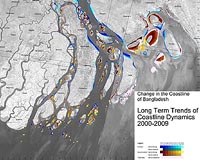 |
Washington DC (SPX) Dec 16, 2009 Researchers studying carbon dioxide, a leading greenhouse gas and a key driver of global climate change, now have a new tool at their disposal: daily global measurements of carbon dioxide in a key part of our atmosphere. The data are courtesy of the Atmospheric Infrared Sounder (AIRS) instrument on NASA's Aqua spacecraft. Moustafa Chahine, the instrument's science team leader at NASA's Jet Propulsion Laboratory, Pasadena, Calif., unveiled the new product at a briefing on recent breakthroughs in greenhouse gas, weather and climate research from AIRS at this week's American Geophysical Union meeting in San Francisco. The new data, which span the seven-plus years of the AIRS mission, measure the concentration and distribution of carbon dioxide in the mid-troposphere--the region of Earth's atmosphere that is located between 5 to 12 kilometers, or 3 to 7 miles, above Earth's surface. They also track its global transport. The product represents the first-ever release of global carbon dioxide data that are based solely on observations. The data have been extensively validated against both aircraft and ground-based observations. "AIRS provides the highest accuracy and yield of any global carbon dioxide data set available to the research community, now and for the immediate future," said Chahine. "It will help researchers understand how this elusive, long-lived greenhouse gas is distributed and transported, and can be used to develop better models to identify 'sinks,' regions of the Earth system that store carbon dioxide. It's important to study carbon dioxide in all levels of the troposphere." Chahine said previous AIRS research data have led to some key findings about mid-tropospheric carbon dioxide. For example, the data have shown that, contrary to prior assumptions, carbon dioxide is not well mixed in the troposphere, but is rather "lumpy." Until now, models of carbon dioxide transport have assumed its distribution was uniform. Carbon dioxide is transported in the mid-troposphere from its sources to its eventual sinks. More carbon dioxide is emitted in the heavily populated northern hemisphere than in its less populated southern counterpart. As a result, the southern hemisphere is a net recipient, or sink, for carbon dioxide from the north. AIRS data have previously shown the complexity of the southern hemisphere's carbon dioxide cycle, revealing a never-before-seen belt of carbon dioxide that circles the globe and is not reflected in transport models. In another major finding, scientists using AIRS data have removed most of the uncertainty about the role of water vapor in atmospheric models. The data are the strongest observational evidence to date for how water vapor responds to a warming climate. "AIRS temperature and water vapor observations have corroborated climate model predictions that the warming of our climate produced as carbon dioxide levels rise will be greatly exacerbated - in fact, more than doubled - by water vapor," said Andrew Dessler, a climate scientist at Texas A and M University, College Station, Texas. Dessler explained that most of the warming caused by carbon dioxide does not come directly from carbon dioxide, but from effects known as feedbacks. Water vapor is a particularly important feedback. As the climate warms, the atmosphere becomes more humid. Since water is a greenhouse gas, it serves as a powerful positive feedback to the climate system, amplifying the initial warming. AIRS measurements of water vapor reveal that water greatly amplifies warming caused by increased levels of carbon dioxide. Comparisons of AIRS data with models and re-analyses are in excellent agreement. "The implication of these studies is that, should greenhouse gas emissions continue on their current course of increase, we are virtually certain to see Earth's climate warm by several degrees Celsius in the next century, unless some strong negative feedback mechanism emerges elsewhere in Earth's climate system," Dessler said. Originally designed to observe atmospheric temperature and water vapor, AIRS data are already responsible for the greatest improvement to five to six-day weather forecasts than any other single instrument, said Chahine. JPL scientists have shown a major consequence of global warming will be an increase in the frequency and strength of severe storms. Earlier this year, a team of NASA researchers showed how AIRS can significantly improve tropical cyclone forecasting. The researchers studied deadly Typhoon Nargis in Burma (Myanmar) in May 2008. They found the uncertainty in the cyclone's landfall position could have been reduced by a factor of six had more sophisticated AIRS temperature data been used in the forecasts. AIRS observes and records the global daily distribution of temperature, water vapor, clouds and several atmospheric gases including ozone, methane and carbon monoxide. With the addition of the mid-tropospheric carbon dioxide data set this week, a seven-year digital record is now complete for use by the scientific community and the public. Share This Article With Planet Earth
Related Links AIRS Earth Observation News - Suppiliers, Technology and Application
 ESA And World Bank Move Towards Closer Collaboration
ESA And World Bank Move Towards Closer CollaborationParis, France (ESA) Dec 16, 2009 The World Bank is a vital source of financial and technical assistance to developing countries around the world. At first glance, this may not appear to be connected to space technology, but large development projects and the state of Earth's environment are intrinsically linked. Global climate change is also an increasingly important challenge in overcoming poverty and advancing ... read more |
|
| The content herein, unless otherwise known to be public domain, are Copyright 1995-2009 - SpaceDaily. AFP and UPI Wire Stories are copyright Agence France-Presse and United Press International. ESA Portal Reports are copyright European Space Agency. All NASA sourced material is public domain. Additional copyrights may apply in whole or part to other bona fide parties. Advertising does not imply endorsement,agreement or approval of any opinions, statements or information provided by SpaceDaily on any Web page published or hosted by SpaceDaily. Privacy Statement |